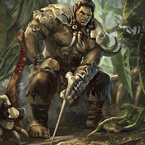In the lead-up to Pro Tour: LA, Rhinar development took a back seat to the new Brute Kayo. Despite that, a handful of dedicated brewers like myself continued to work on the Reckless Rampage because we believed that he had a unique edge into the field. The shape of that edge, however, went in different directions - conventional theory leaned harder into intimidate than ever before, while I pushed the consistency high enough to support Pummel (more on that later). Fortunately, both versions found success - Pablo achieved an outstanding 19th place in the Pro Tour, and I was the highest placing Rhinar in The Calling at a coincidental 19th as well.
Before the big weekend, I lacked data to give me confidence in my beliefs; but after making Day 2 of the Pro Tour (subsequently dropping) and going 10-3 at The Calling, I can say that Rhinar is a unique threat to the metagame - a disruptive menace in skilled hands, capable of shifting unpredictably between offense and defense.
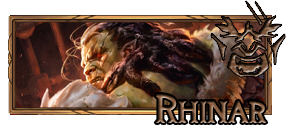
Today I’ll walk you through what’s new as of Heavy Hitters, how it impacts deck construction for the green man, and how I expect he’ll fit into a new metagame following Dromai’s ascension to Living Legend.
Fresh Meat
The most obvious boon from Heavy Hitters is the new best-in-slot arm piece: Apex Bonebreaker. The armor alone elevates Brute resilience to Guardian levels, but the additional effect of creating Might tokens establishes this as one of the best equipment pieces ever printed. Because it's replacing Gambler’s Gloves for most matchups, activating Scabskin Leathers is a more risky affair than ever; but it further rewards those who have mastered Brute’s complex risk/reward matrix.
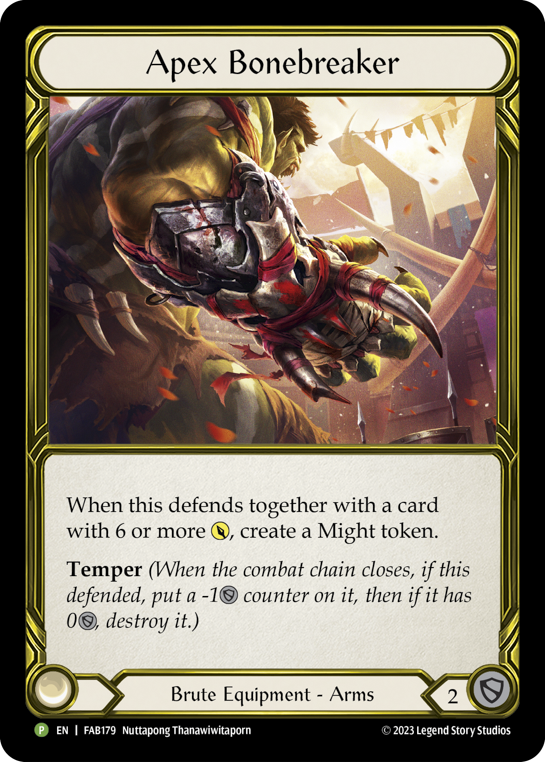
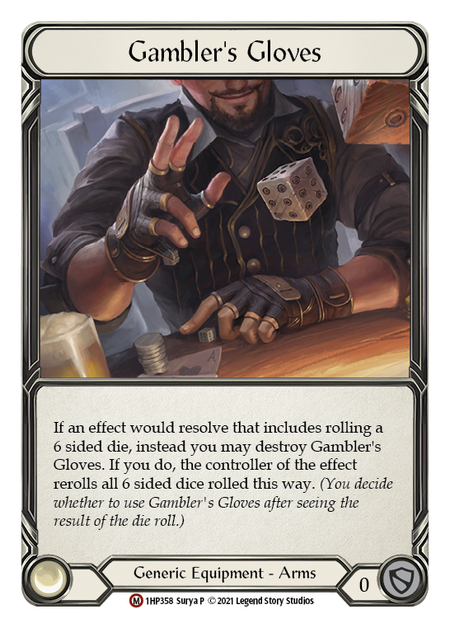
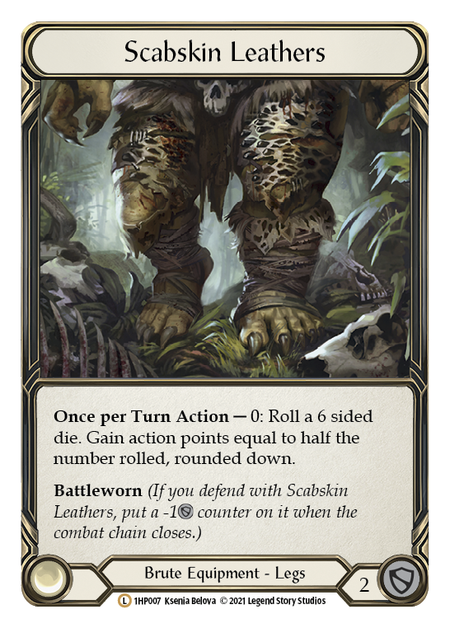
Of the attacks, Send Packing and Show No Mercy are standouts, both of which hone in on the disruptive effects Rhinar thrives on. On its own, Send Packing is a perfect combination of stats and effect that serves every part of the deck infrastructure. Paired with Apex Bonebreaker’s Might token, it paralyzes aggro decks and buys valuable space to resolve a Bloodrush Bellow.

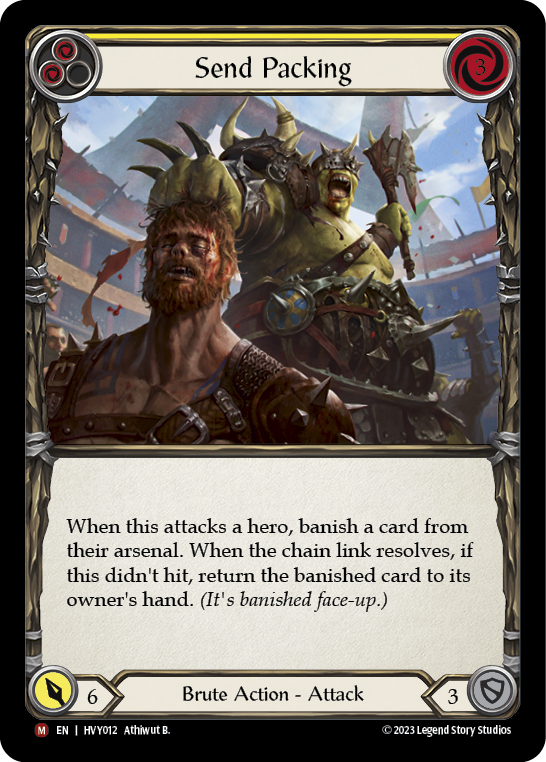
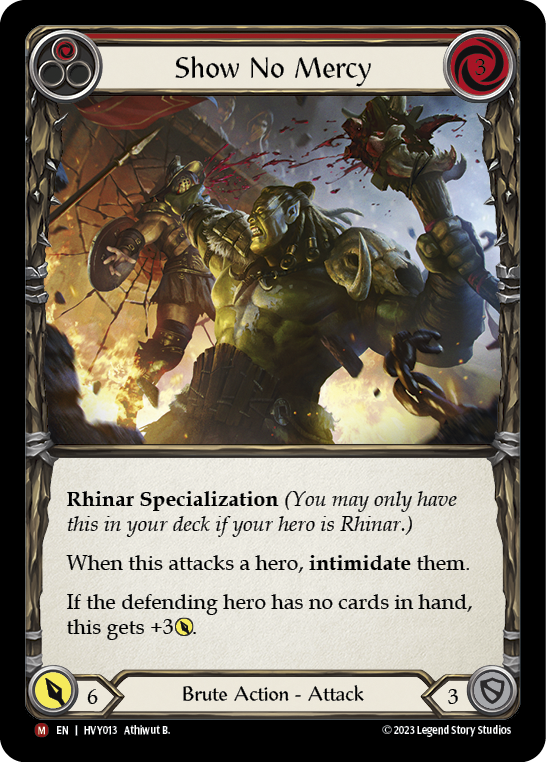
Conversely, Show No Mercy disrupts decks that want to block. Essentially a clunkier Pack Hunt on its own, it truly shines when you end a multiple attack chain with it to threaten 9 damage, lest your opponent block in ways they don’t want to.
Runner Runner and Agile Windup form an Agility token foundation that seems unremarkable at first glance, but has devastating implications for decks that have traditionally tried to block Rhinar out and wait for him to fail to convert a hand. At first glance, Runner Runner seems out of place in a deck that has a relatively inconsistent amount of Agility generation; in practice, however, it's an excellent all-rounder by virtue of being a 2-cost Brute card. It’s one of the premium cards to place in arsenal because it has so many use cases: obviously it preserves your Agility token, but it also has synergy with the classic Tunic and Pummel combo while fitting within the cost and type constraints of a perfect Bloodrush Bellow turn.
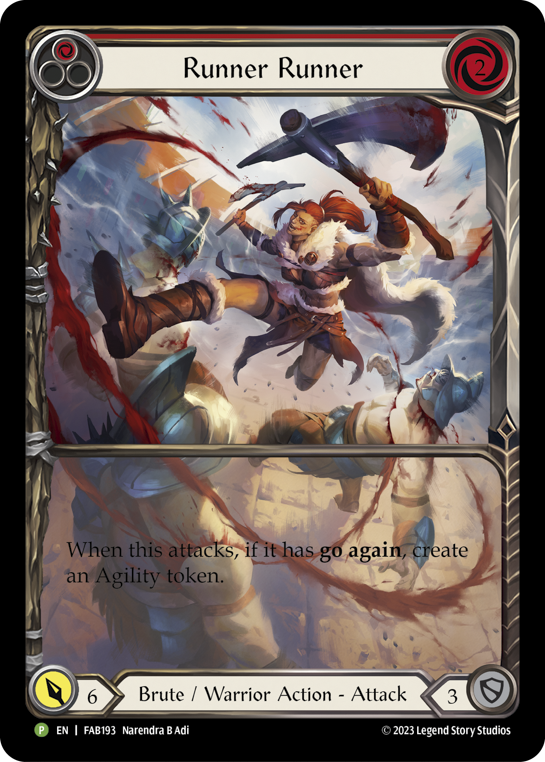
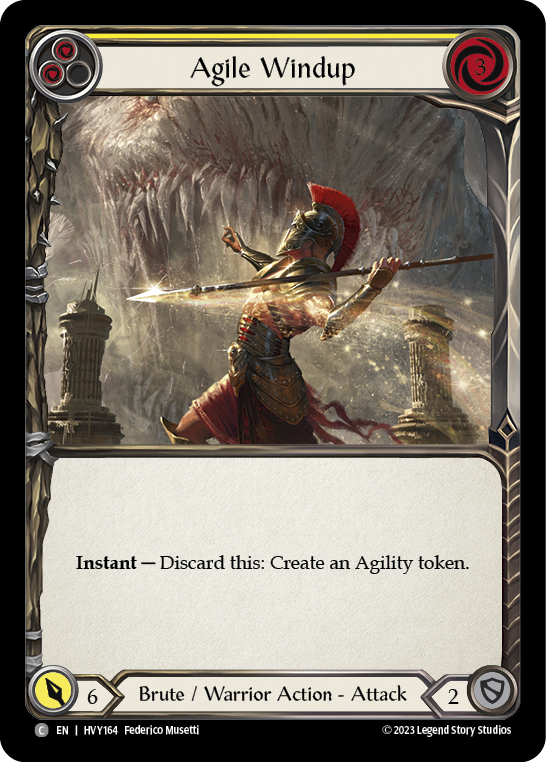
Agile Windup is the unassuming workhorse of this deck. This card is so incredibly elegant that it almost deserves its own article. (We still have a lot to talk about though, so I’ll summarize.) Its role is to generate sustained offense against decks that try to block us out. By discarding it, you get three effects: you get your Agility token, but you also trigger Rhinar’s Intimidate ability, and meet the condition for giving Mandible Claws go again.
Agile Windup is an unassuming workhorse... so incredibly elegant that it almost deserves its own article.
On the turn you activate it, you unlock a whole range of hands to play. You can have a very compact turn by swinging your claws with a blue plus Tunic resource; you can play your whole hand out; or you can merge the two lines with a 2-cost like Pack Hunt. When the agility token triggers next turn, you get to maintain pressure with Savage Feast, Runner Runner, or anything else you established in arsenal. The utility of an instant speed intimidate can’t be understated either - try playing Show No Mercy into a deck that wants to block it out, then intimidate their last card at instant speed to punch through damage, or respond to Kano Ragamuffin’s Hat on your turn to stymie their combo.
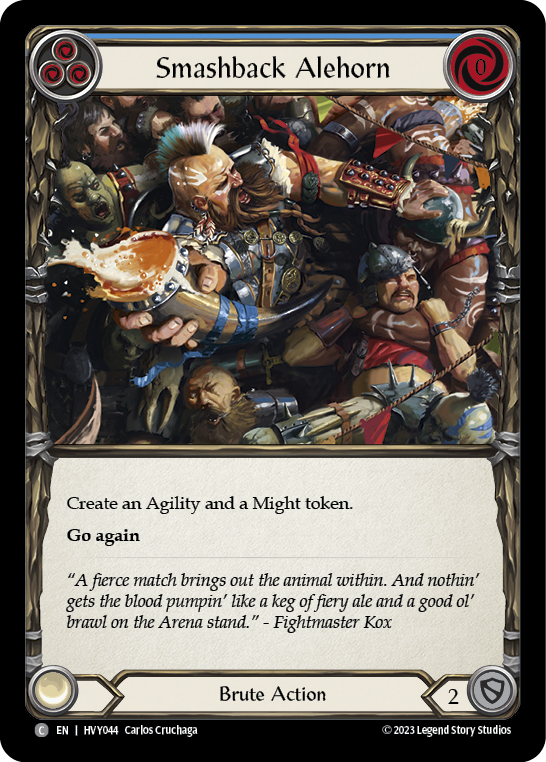
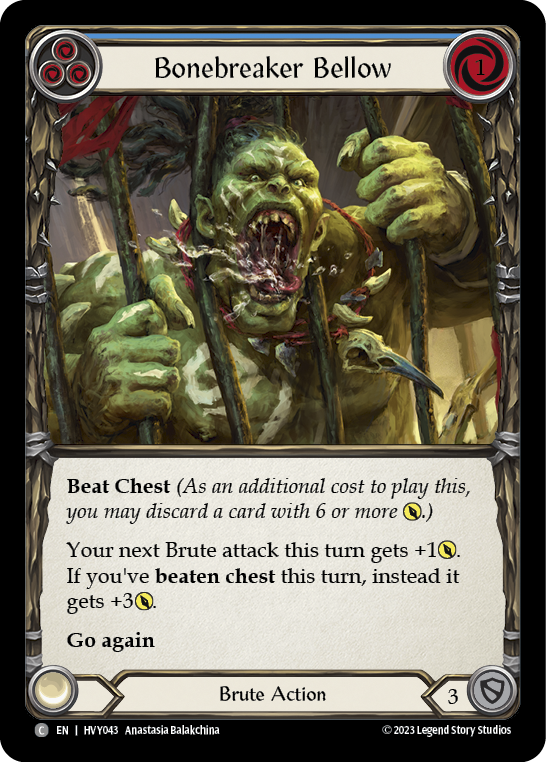
The blue base is also noticeably overhauled compared to previous iterations. Gone are most of the intimidate effects in favor of cards that we’re happy to play when we’re stuck with them. Smashback Alehorn is not only an excellent play on the first turn, it's also something that can hold in arsenal to efficiently cash it out by attacking with a 2-cost and a Claw. Bonebreaker Bellow is something we keep in the deck for the last turns of the game where a hand with 4 blues (one of which Wrecker Romp) can attack for 9. Talk a Big Game demands interaction from aggro decks when we draw more pitch than we need on Bloodrush turns. Lastly, while it didn’t debut in Heavy Hitters, Dig Up Dinner also bears mention. Shuffling in up to three attacks and gaining life is an incredible amount of fatigue resilience for a blue 3-block. I often consider taking damage to play this card if I have a feeling the game will go long enough.
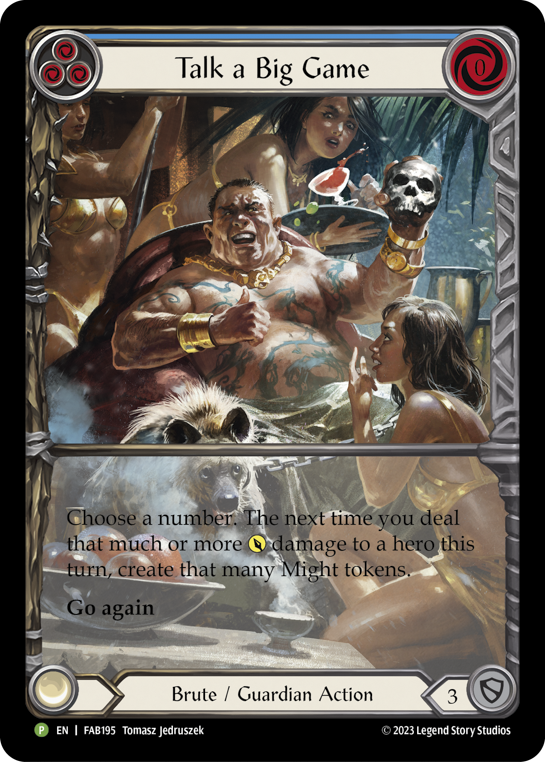
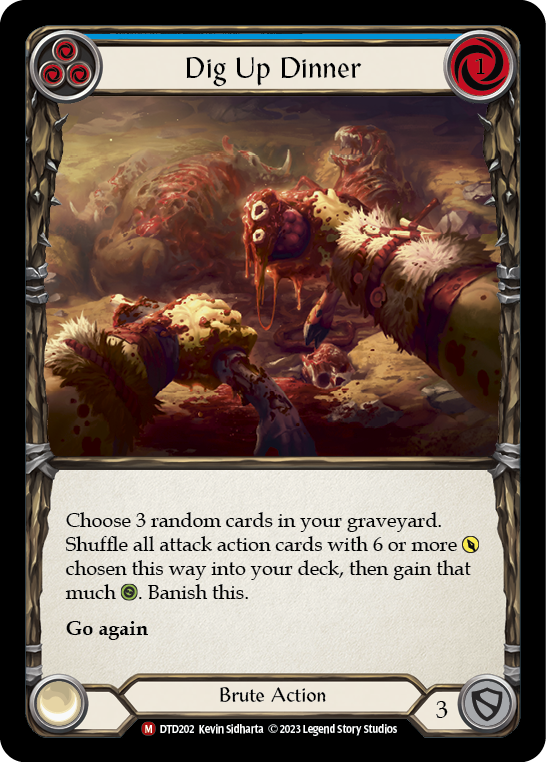
Evolving Strategies
Historically, Rhinar has been faced with an ugly decision in deckbuilding - what kind of bad cards do you want to run? Do you want mediocre yellow 6-power attacks, or do you want blues with virtually no text? Both of them are necessary to add consistency to Bloodrush turns, but adding too many of them makes every other turn feel toothless without support from cards like Barraging Beatdown or Pummel.
The introduction of so many robust 6-power attacks and blues means that the deck no longer has to choose between power and consistency: you can do both, and with less slots. This affords us room to run tech cards… and Pummel.

People who know me might remember that I was one of the first detractors of Pummel in Rhinar. In those days, I argued that everything about the card hurts Bloodrush - it pitches poorly, it’s not a 6-power, and it blocks for 2. In a deck that relied on every Bloodrush to be a home run, that was simply too risky a proposition. With the creation of a more resilient Bloodrush skeleton, Pummel fail states are far rarer now. Additionally, the introduction of Send Packing alongside a slew of 2-cost attacks we’re excited to arsenal gives us a devastating sucker punch for aggro decks which have historically been a sore spot for us.
So, what do all these changes add up to?
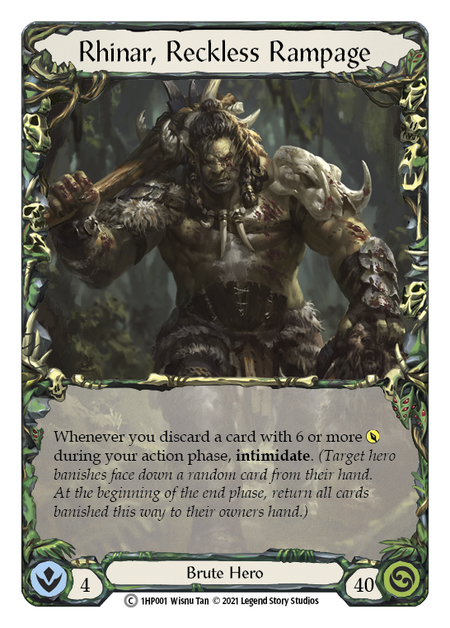
Weapons
Equipment
- Scabskin Leathers (1)
- Scowling Flesh Bag (1)
- Nullrune Gloves (1)
- Fyendal's Spring Tunic (1)
- Gambler's Gloves (1)
- Apex Bonebreaker (1)
- Skullhorn (1)
Loadout
- Agile Windup (Red) (3)
- Alpha Rampage (Red) (2)
- Barraging Beatdown (Blue) (3)
- Beast Within (Yellow) (3)
- Bloodrush Bellow (Yellow) (3)
- Bonebreaker Bellow (Blue) (3)
- Dig Up Dinner (Blue) (3)
- Argh... Smash! (Yellow) (1)
- Pummel (Red) (2)
- Pack Hunt (Red) (3)
- Remembrance (Yellow) (1)
- Fate Foreseen (Red) (1)
- Agile Windup (Yellow) (3)
- Reckless Swing (Blue) (2)
- Command and Conquer (Red) (3)
- Sink Below (Red) (3)
- Oasis Respite (Red) (2)
- Show No Mercy (Red) (3)
- Send Packing (Yellow) (3)
- Skull Crack (Red) (3)
- Smashback Alehorn (Blue) (3)
- Swing Big (Red) (3)
- Talk a Big Game (Blue) (3)
- Warmonger's Diplomacy (Blue) (3)
- Runner Runner (Red) (3)
- Savage Feast (Red) (3)
- Wrecker Romp (Blue) (3)
Compared to past iterations of Mandible Claw Bloodrush builds, there are a couple things of note. Firstly, the blue count is considerably higher than before, and the 6-power attack count sits comfortably at 30 with an option to board up to 37. Where did all the space come from? I’ve slashed the staple intimidate package of the past - but why would I do that?
To answer that, let's examine the history of Barraging Beatdown.

Let’s note Rhinar’s defining strength and weakness. His strength lies in cracking through the blocks of defensive decks, and his most salient weakness is poor hand compression - it is quite difficult for him to leverage more than a 2-card hand efficiently. Barraging Beatdown has been a staple of his deck building because it both hones in on his strength, and offsets his weakness. The fundamental tension with this card, however, is that it’s not a 6-power attack, which impacts the consistency of Bloodrush. Put simply, it incurs a heavy deck building cost.
However, if Barraging Beatdown is too expensive, we can’t just cut it - we need the functionality it offers. Here’s where we put on our Moneyball caps and start thinking like Billy Beane: if we cut red and yellow Barraging Beatdowns, we recreate it in the aggregate. Agile Windups extend our hands, Show No Mercy cracks through defensive decks on Bloodrush turns, Dig Up Dinner gives us a new kind of fatigue resilience. If we come up a little short on damage output? Well that’s what the Remembrance is for!
Barraging Beatdown has been the catch-all antidote for defeating defensive decks, but we don’t need it anymore - the deck is better than ever against those kinds of decks without it. Of course we lose some of Rhinar’s robbery factor without it - watch Pablo’s last turn against Allen Lau round 11 of Pro Tour: LA for a prime example - but we achieve almost everything else Barraging Beatdown offers, with a more consistent deck than ever.
A Dragon Hunter without Prey
Here’s a tricky question: if I chose to play Rhinar in LA because I wanted to beat Dromai, why would I play Rhinar after she rotates?
Indulge my theory on the competitive ecosystem for a couple paragraphs. Dromai is a deck with many polarizing matchups - many decks are competitively dubious because they lack any means to win the game against Dromai. Many of these decks are also defensive in nature. Some examples include Arakni, Teklovossen, and Riptide. While these are broadly considered meme heroes, they become a lot less funny when their worst match up ceases to exist.
And why would anyone want to play these heroes? With Kayo acting as the new metagame threat, there will be a race to find the hero with the right combination of disruption and defense to take the crown of Kayo-Killer. So I imagine a new metagame will form a triangle of Kayo, Kayo-Killers, and Kayo-Killer-Killers. Rhinar sits comfortably in the third group while still having an effective game plan to beat all but the most skilled Kayo pilots.
That’s not to say he’s without poor match ups. Kassai’s raw efficiency and long-term sustainability asks the deck to never miss on a Bloodush - something we still can’t perfectly control - and expert Katsu pilots are always one touch away from winning when we only have so much disruption to stave them off.
Final Thoughts
The advent of Heavy Hitters caused a major shift in the metagame, and Dromai’s success at the Pro Tour ensures that another one will follow shortly. Whenever the metagame gets unstable, decks with strong fundamental tools rise to the top. In my experience, Rhinar is no stranger to this pattern. With an invigorated card pool and divergent successful builds, I expect this year to be one of Rhinar’s best.


